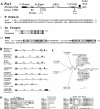A family of RS domain proteins with novel subcellular localization and trafficking
- PMID: 15741184
- PMCID: PMC552957
- DOI: 10.1093/nar/gki269
A family of RS domain proteins with novel subcellular localization and trafficking
Abstract
We report the sequence, conservation and cell biology of a novel protein, Psc1, which is expressed and regulated within the embryonic pluripotent cell population of the mouse. The Psc1 sequence includes an RS domain and an RNA recognition motif (RRM), and a sequential arrangement of protein motifs that has not been demonstrated for other RS domain proteins. This arrangement was conserved in a second mouse protein (BAC34721). The identification of Psc1 and BAC34721 homologues in vertebrates and related proteins, more widely throughout evolution, defines a new family of RS domain proteins termed acidic rich RS (ARRS) domain proteins. Psc1 incorporated into the nuclear speckles, but demonstrated novel aspects of subcellular distribution including localization to speckles proximal to the nuclear periphery and localization to punctate structures in the cytoplasm termed cytospeckles. Integration of Psc1 into cytospeckles was dependent on the RRM. Cytospeckles were dynamic within the cytoplasm and appeared to traffic into the nucleus. These observations suggest a novel role in RNA metabolism for ARRS proteins.
Figures






Similar articles
-
An RNA recognition motif (RRM) is required for the localization of PTB-associated splicing factor (PSF) to subnuclear speckles.Exp Cell Res. 2001 Feb 1;263(1):131-44. doi: 10.1006/excr.2000.5097. Exp Cell Res. 2001. PMID: 11161712
-
A novel nucleocytoplasmic shuttling sequence of DAZAP1, a testis-abundant RNA-binding protein.RNA. 2006 Aug;12(8):1486-93. doi: 10.1261/rna.42206. Epub 2006 Jun 13. RNA. 2006. PMID: 16772659 Free PMC article.
-
The cold-inducible RNA-binding protein migrates from the nucleus to cytoplasmic stress granules by a methylation-dependent mechanism and acts as a translational repressor.Exp Cell Res. 2007 Dec 10;313(20):4130-44. doi: 10.1016/j.yexcr.2007.09.017. Epub 2007 Sep 29. Exp Cell Res. 2007. PMID: 17967451
-
A sequence motif conserved in diverse nuclear proteins identifies a protein interaction domain utilised for nuclear targeting by human TFIIS.Nucleic Acids Res. 2006 Apr 28;34(8):2219-29. doi: 10.1093/nar/gkl239. Print 2006. Nucleic Acids Res. 2006. PMID: 16648364 Free PMC article.
-
Nuclear speckles: a model for nuclear organelles.Nat Rev Mol Cell Biol. 2003 Aug;4(8):605-12. doi: 10.1038/nrm1172. Nat Rev Mol Cell Biol. 2003. PMID: 12923522 Review.
Cited by
-
Protein Kinase C Theta Modulates PCMT1 through hnRNPL to Regulate FOXP3 Stability in Regulatory T Cells.Mol Ther. 2020 Oct 7;28(10):2220-2236. doi: 10.1016/j.ymthe.2020.06.012. Epub 2020 Jun 15. Mol Ther. 2020. PMID: 32592691 Free PMC article.
-
Lamin B receptor: multi-tasking at the nuclear envelope.Nucleus. 2010 Jan-Feb;1(1):53-70. doi: 10.4161/nucl.1.1.10515. Nucleus. 2010. PMID: 21327105 Free PMC article. Review.
-
PKC-Theta is a Novel SC35 Splicing Factor Regulator in Response to T Cell Activation.Front Immunol. 2015 Nov 5;6:562. doi: 10.3389/fimmu.2015.00562. eCollection 2015. Front Immunol. 2015. PMID: 26594212 Free PMC article.
-
ARGLU1 is a transcriptional coactivator and splicing regulator important for stress hormone signaling and development.Nucleic Acids Res. 2019 Apr 8;47(6):2856-2870. doi: 10.1093/nar/gkz010. Nucleic Acids Res. 2019. PMID: 30698747 Free PMC article.
-
A screen for modifiers of hedgehog signaling in Drosophila melanogaster identifies swm and mts.Genetics. 2008 Mar;178(3):1399-413. doi: 10.1534/genetics.107.081638. Epub 2008 Feb 3. Genetics. 2008. PMID: 18245841 Free PMC article.
References
Publication types
MeSH terms
Substances
Associated data
- Actions
- Actions
LinkOut - more resources
Full Text Sources
Molecular Biology Databases

